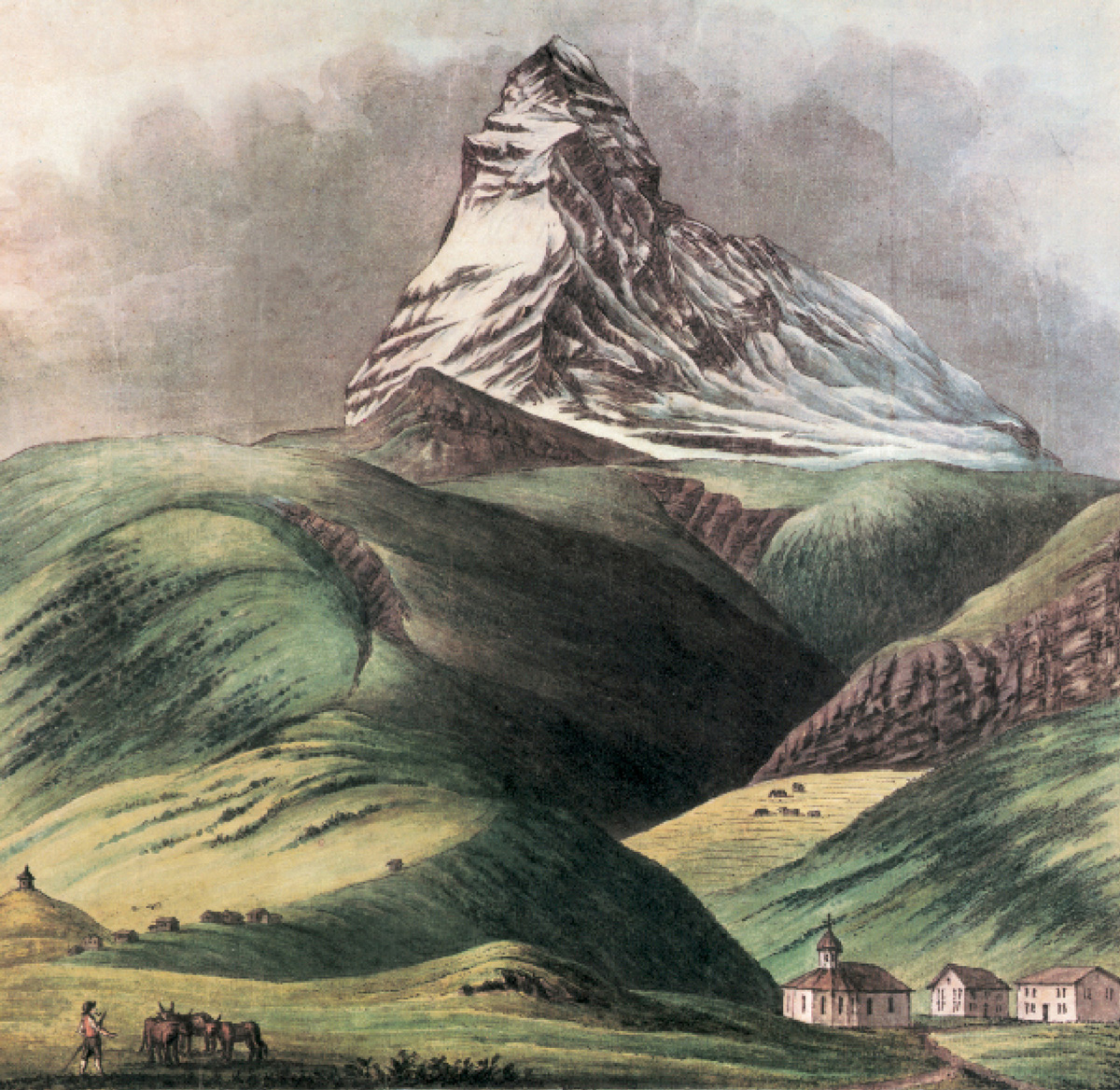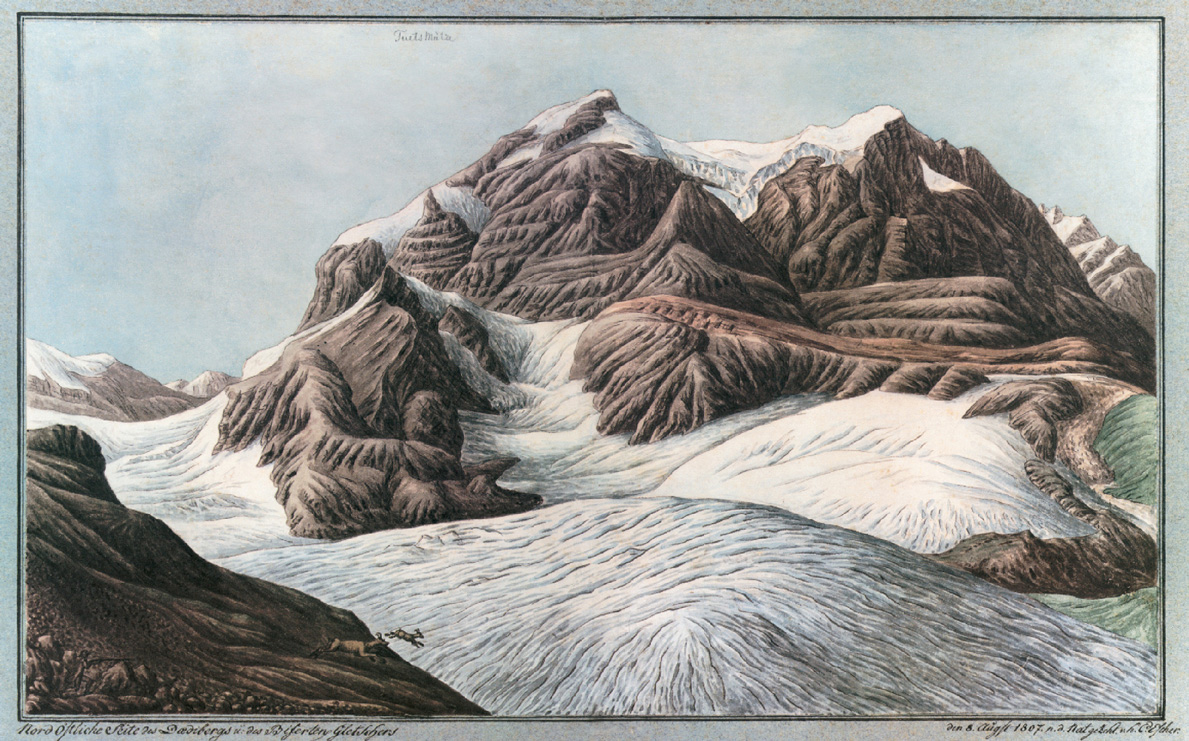Surveying the Alps
The mountain views of Hans Conrad Escher
Jeffrey Kastner

In 1971, the Swiss historian Gustav Solar was invited to organize a small exhibition for Zurich’s Central Library of watercolors by Hans Conrad Escher.[1] Escher was hardly a household name as an artist even in his native Switzerland, but he is a historical figure of some note there, remembered both for the conciliatory role he played as a statesman during the short-lived Helvetic Republic in the years following the French invasion in 1798 and for the large engineering project involving the diversion of the country’s Linth River that he directed in the first decade of the nineteenth century. Involving the creation of canals to redirect the watercourse—industrial deforestation had caused the river to flood the lowlands surrounding it in the canton of Glarus, turning once rich agricultural plains into malarial swampland—the plan became so identified with Escher that following his death, the Swiss state took the highly unusual step of pending the honorific “von der Linth” to the end of his family name.
The occasion for Solar’s exhibition in Zurich was a gift made to the library of eighteen modest watercolors produced by Escher while he was a teenager; these joined a dozen landscape paintings, executed in his later years, already in the collection. But in the course of his research, Solar, who specialized in Alpine history, also uncovered evidence that these hobbyist works were only a small fraction of the statesman’s total artistic output. Along with his background in engineering and economics, Escher was also a keen amateur geologist, botanist, and orologist who spent the last thirty years of his life making regular trips into the Alps. Following up on a note he discovered in a nineteenth-century biography of Escher referring to a huge cache of mountain drawings that he had executed between 1785 and 1822, Solar located an old cupboard in the Geological Institute of Zurich that had been bequeathed to the institute by Escher’s son Arnold Escher von der Linth, himself an eminent geologist. Inside it, he found sixteen parcels containing some nine hundred of the never-before-seen drawings. The materials—meticulous views of hundreds of different peaks, valleys, and glaciers—constitute the most wide-ranging set of early views of the Alpine landscape in existence, a group of works with not only geological but also historical significance that depict, in vivid detail, Europe’s most famous mountain range at that moment when its resonance as a subject of scientific interest was first coming into full flower.
Born in 1767 into a prominent merchant family in Zurich, Escher showed talent with drawing and painting as a young man and studied at an art school in his native city before moving to Geneva when he was seventeen, where he continued lessons with private tutors in art, theology, and philosophy. Though he traveled widely throughout Europe during these years, it was in Geneva that his lifelong interest in the mountains first emerged in earnest. The peaks of the Alps and the Jura are visible from the city, and the Alpine landscape had long figured into the cultural imagination of the region’s peoples, but it was not until the middle of the eighteenth century that the mountains began to be seen as a fitting subject of exploration and study. A landmark moment in this transition occurred in 1741, when a party of Englishmen then living in Geneva—led by a young Norfolk-born theatrical impresario named William Windham, his tutor Benjamin Stillingfleet, and the experienced adventurer Richard Pococke—organized an expedition into the Alps to explore their legendary glacièrs, which to that point had never been properly surveyed.

The English expedition successfully traversed the passes around nearby Chamonix, visiting several valleys and glaciers there, and Windham’s subsequent correspondences to friends and colleagues quickly sparked a new interest in the area both in England and on the Continent. The following year saw a more rigorously scientific assay of the Chamonix glaciers by the Genevese engineer Pierre Martel (it was in his writings that the name “Mont Blanc” first appeared in print) who took temperature and barometric readings along the way and, upon his return, produced the first comprehensive map of the region, identifying various peaks with the names by which the locals had long called them. Over the next two decades, a growing number of parties would venture into the mountains: the Swiss brothers Jean-André and Guillaume Antoine Deluc began a series of expeditions in 1754, gathering rock samples for their private mineralogical museum, and in 1760 Horace-Bénédict de Saussure—considered the greatest of the early Alpine explorers—made the first of more than a dozen trips into the highest reaches of the Alps, which he recounted in his multivolume Voyages dans les Alpes (1779–1786). These investigations, and the observations of the Alpine rock types and formations they produced, made important contributions to the burgeoning science of geology, or geognosy, as the study of the earth’s structure—and particularly the disposition and relationship of its various strata—was then known, after a coinage by one the most influential earth scientists of the time, Abraham Werner.[2]
Escher was particularly fascinated by de Saussure’s highly detailed accounts, which were published in Geneva, and in 1785 he embarked on his first trip into the mountains, accompanied by his tutor, the biologist Jean-Pierre-Ètienne Vaucher. Over the next few years, he and Vaucher would climb dozens of peaks in the area around Geneva—often taking on difficult technical routes through areas such as the Brunni Glacier and the Vorderrhein Valley, and over the Sandalp Pass to the peaks of Tödi, a route on which, some twenty years later, Escher would nearly lose his life when he slipped and found himself hanging from the lip of a deep crevasse. By his early twenties, Escher had returned to Zurich where, befitting his aristocratic position, he began to take on a series of increasingly prominent military, judicial, and political positions. He married Regula von Orelli in 1790 and together they had nine children—only one son, Arnold, and five daughters survived infancy. Escher’s service in a variety of civic capacities allowed him the leisure (joined quite frequently by members of his family including, somewhat unusually for the time, his daughters) to make literally hundreds of trips, short and long, into the Alps. There, he began to employ his artistic skills in an attempt to capture the vistas with a visual clarity that he hoped might rival the written descriptions of de Saussure.
Escher made his hundreds of drawings and watercolors in a variety of ways, sometimes rendering a view to conclusion as he surveyed it in the field; other times doing sketches on site and then completing them, with the aid of detailed notes describing the forms and positions of various rock formations—his interest in geognosy meant that particular attention was paid to the various layers of rocks, their shapes and contours always very clearly defined—once he returned from his trips. The various images executed by Escher can, observes Solar, be generally divided into two main types. The most numerous are the Views, small renderings (typically less than 12 x 12 inches) that feature distinct, compositionally finite views, often with clear figurative, domestic, or agrarian details, and are framed on blue-gray backing paper he obtained from the cast-offs of a Zurich printing house. (His 1806 image of the Matterhorn is one of the finest examples of the View style.) The other category is that of the Panoramas—larger (up to 36 inches long) scroll-like works that borrow and generalize the compositional procedures pioneered only a few decades prior by the Edinburgh-based painter Robert Barker (considered the inventor of the panorama) to create extraordinary 360-degree images of entire Alpine ranges, as in his 1806 view of the Val d’Aosta area, or the 1820 panorama, one of his last major paintings and among his most expressionistic pictures, featuring the Brenva Glacier near the town of Entrèves.
Just as in his life, Escher gravitated toward the mountains in his last days. A chronic intestinal disorder began troubling him in the spring of 1822—in July of that year, he walked with his son Arnold over the mountains to the Valais spa town of Leukerbad where he took the waters for four weeks, but his illness did not respond to the treatment. The return to Zurich from Valais would be Escher’s last journey into his Alps—he died at home in March of 1823.
- This article is indebted to Solar’s comprehensive book, Hans Conrad Escher von der Linth: Views and Panoramas of Switzerland, 1780–1822 (Zurich: Atlantis Verlag AG, 1975). The English edition, translated by Stanley Mason, is an abridged version of the German language original, first published in 1974. Both are out of print.
- Werner was a German scholar who was instrumental in the development of mineralogy. A celebrated teacher at Freiberg’s Mining Academy, he famously advocated the theory of Neptunism—that the earth’s crust was sedimentary, laid down by a colossal ocean that once covered the entire globe before slowly receding to its present-day boundaries. This was contrasted with the notion of Volcanism, which essentially posited that the geological record was created by a series of volcanic eruptions. The debate between the followers of these two competing theories was of interest to more than the scientific community, touching as it did on theological issues around the creation of the earth. Goethe, for instance, was much engaged with the controversy, even dedicating a portion of Part 2 of Faust to it in the form of the debate between Anaxagoras, who advocates Volcanism, and Thales, whose defense of Neptunism—Goethe’s preferred theory—prevails. For more on the debate between Volcanists and Neptunists, see Maiken Umbach’s commentary here and Chadwick Dalton’s text here.
Jeffrey Kastner is a Brooklyn-based writer and senior editor of Cabinet.